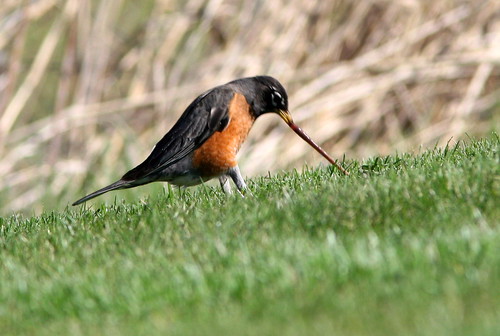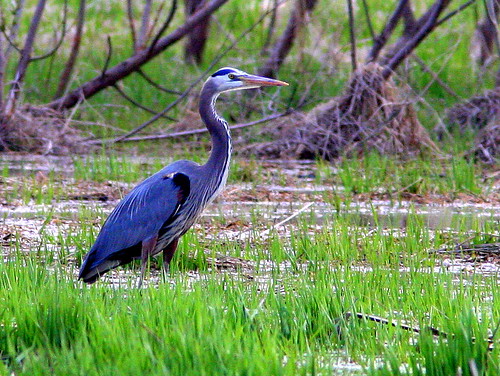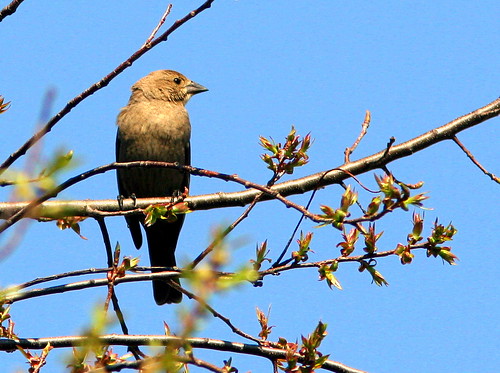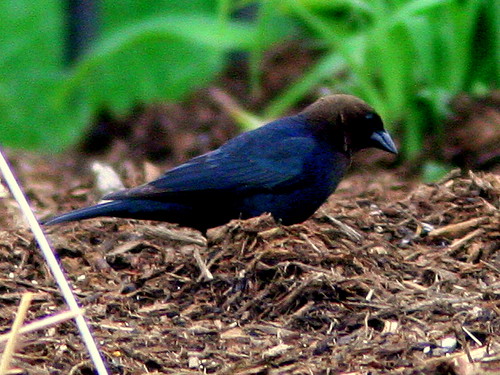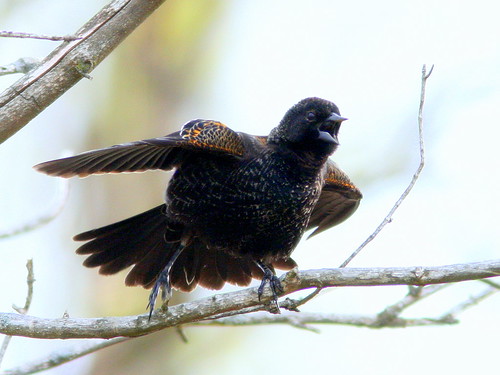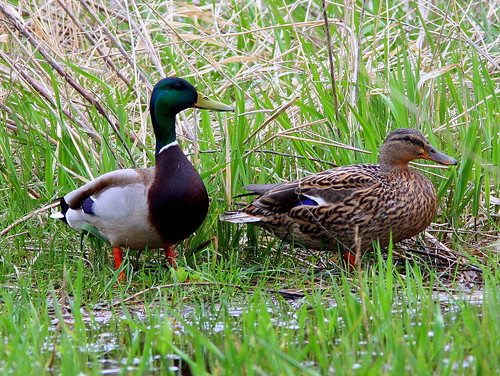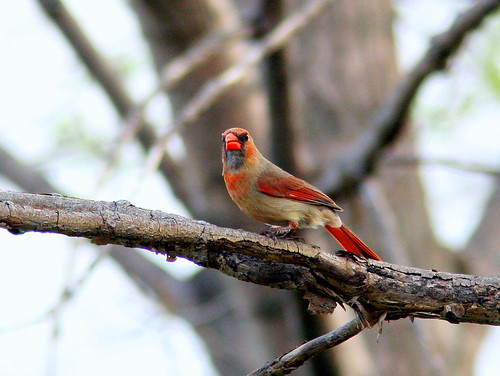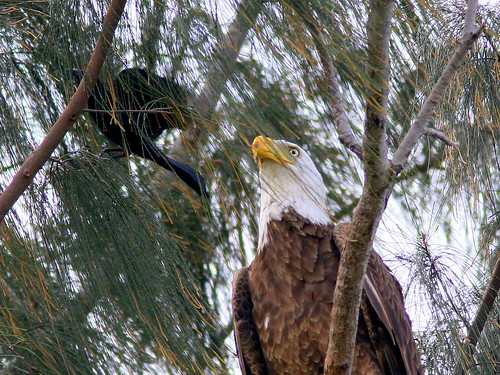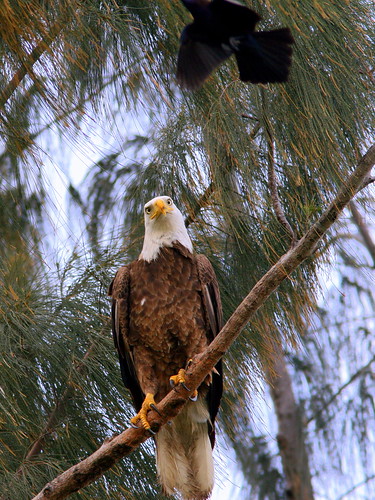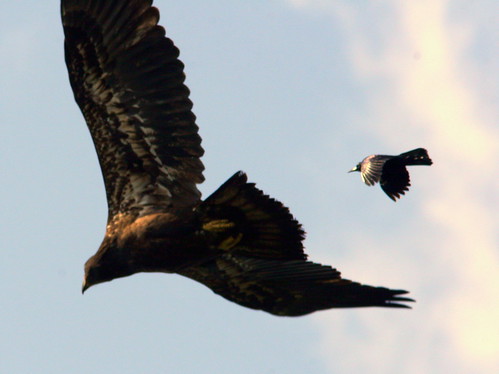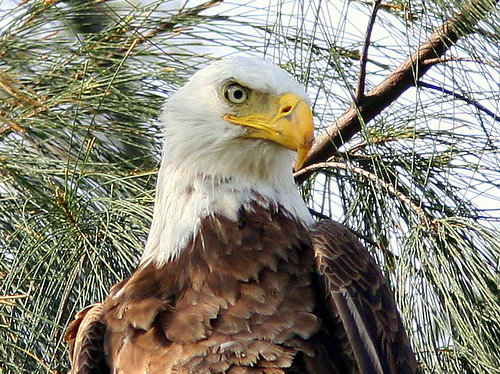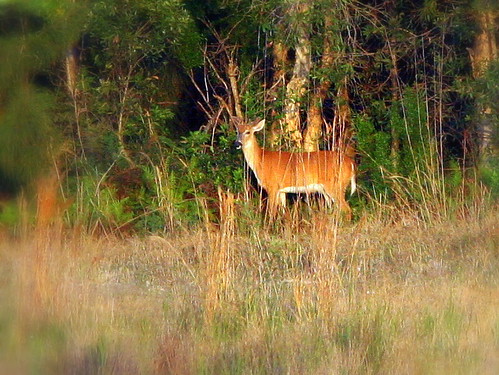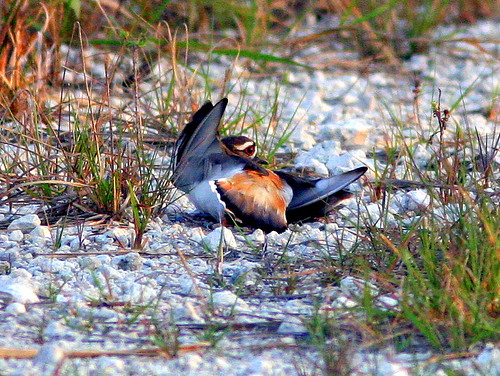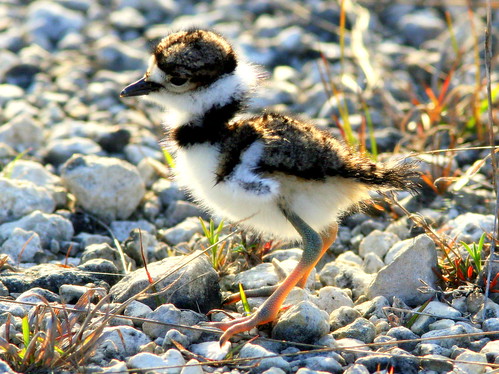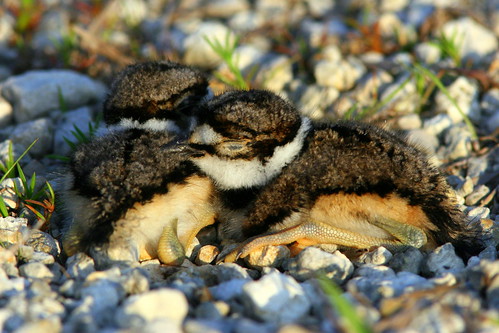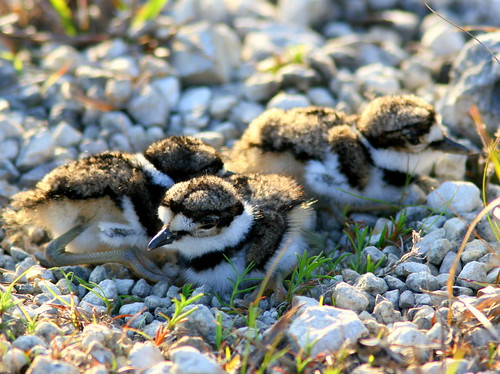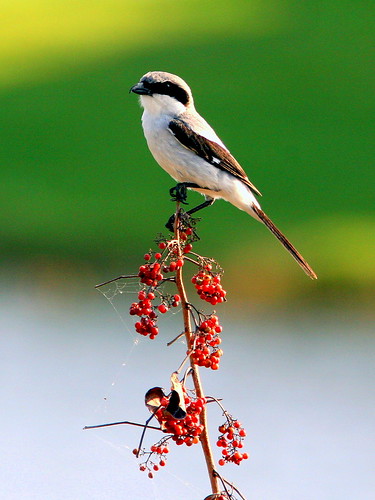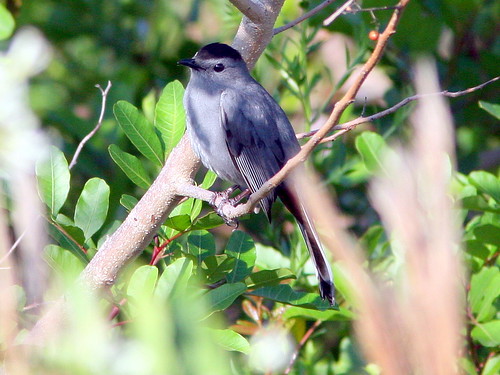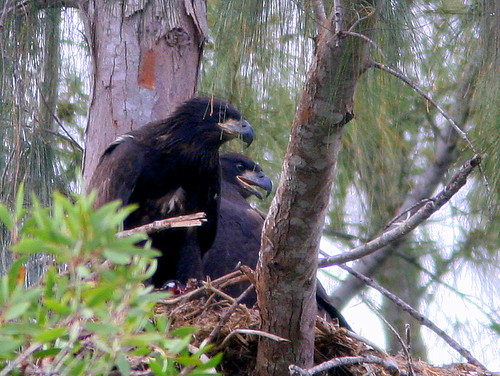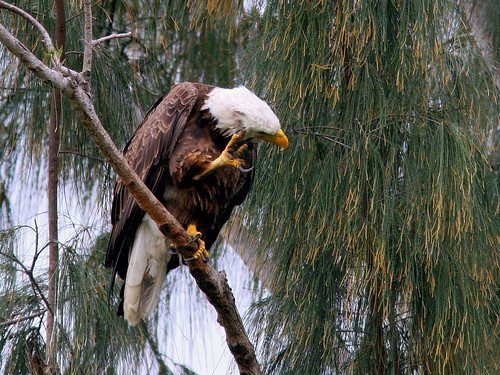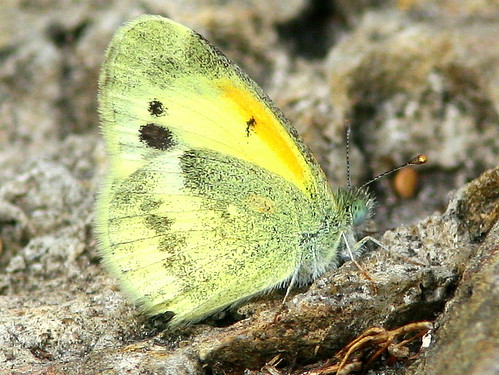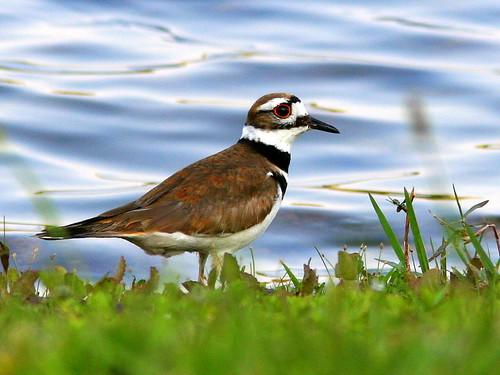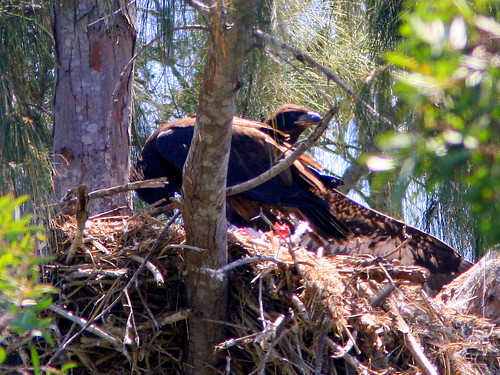Posted by: Ken @ 10:01 am
After participating with a hard-core bunch who have monitored the local Bald Eagle nest since two eggs were laid in mid-December, we must now be content in our new role as virtual eagle-watchers. Here is Mike Fossler’s slide show depicting recent events in the lives of the two Pembroke Pines eaglets, Hope and Justice, now 14 weeks old and flying freely for three weeks. They still return to the nest to rest and sometimes are fed by their parents, but they are surely learing how to find food on their own. (If you have trouble loading it, access the slideshow directly at this link):
It had snowed in Chicagoland the day before we arrived. To our delight, temperatures had warmed to the high 70s by noon, and the sun was shining bright. We took our three year old granddaughter to nearby Jones Meadow Park. While Mary Lou supervised her at the swings and slides near the park entrance, I walked the 3/4 mile asphalt path that skirts a lake, woods and wetlands to the north, and the back yards of homes to the south. The brown grasses and sedges have been flattened by the weight of the past winter’s generous snowfall. Low spots in the meadows and woods are flooded in spots aptly called “fluddles” by local birders. Various frogs and toads chirp and croak. The trees are mostly bare, though willows at the edge of the path are greening up.
Early-blooming White Trout Lilies abound at woodland edges and openings:
Willow shoots push through the asphalt track with energy and exuberance that signals, indeed, spring has arrived:
In Florida, American Robins are often hit-and-miss during the winter, and disappear to the north for the rest of the year.
This guy has to work hard for his breakfast:
A Great Blue Heron wades thigh-deep in a flooded meadow:
This Song Sparrow sang blissfully, until he eyed…
… a parasitic female Brown-headed Cowbird, waiting for the sparrow’s mate to begin laying her eggs:
A male cowbird forages nearby:
This first-year male Red-winged Blackbird lacks the bright coloration of the older males, but sings its “Konk-ra-lee” song and displays shoulder patches with only a hint of red:
A Downy Woodpecker is captured in mid-leap:
A pair of Mallards may be looking for a nesting site above the water level:
A female Northern Cardinal brightens up the leafless branches:
| PEMBROKE PINES BALD EAGLES |
| Nest Watch Page |
| History of the Eagle Nest |
| Protecting the Eagle Nest Site |
| EagleWatch FORUM |
| FAQs |
| Subscribe to this BLOG (RSS) |
Several times, watchers at the urban nest of the Pembroke Pines (Florida) Bald Eagles saw Northern Mockingbirda and Common Grackles approach closely to adult and fledgling eagles, apparently trying to drive them off a favored roosting tree.
Smith, one of the veteran nest observers, captured this video of the action the day before yesterday:
I was shooting the scene next to Smith, and, a few times, saw a grackle actually pull at the adult eagle’s tail feathers. My shutter lag and my (much greater) reaction time made me miss photographing these close encounters, at least one of which appears on Smith’s video.
Here, a grackle makes a very close pass at the eagle’s head:
The adult keeps its eyes on the attacking blackbird, but actually seems passive and never strikes out at it:
Later, a grackle is poised to swoop down on Hope, the larger and older of the 13 week old eaglets:
The young eagle has suffered enough abuse at the hands of a small flock of Common Grackles, and flies away, but one grackle does not give up so easily:
The eaglet flew directly over my head, so fast and low that I could hardly keep it in the camera’s viewfinder:
Why do small birds sometimes seem to put themselves at risk by harassing and even attacking much larger raptors? I have seen fragile little chickadees, titmice, and nuthatches join larger robins and jays to surround and scold a hapless Long-eared Owl or Red-tailed Hawk. Sometimes, mammals such as chipmunks and squirrels join the birds, calling excitedly and flicking their tails nervously.
Red-winged Blackbirds are known perch on the backs of larger hawks to pluck a few feathers as they drive them away from their nesting grounds. In my New Mexico back yard, I once watched several Mountain Chickadees and Bushtits join a group of jays and Clark’s Nutcrackers to take on a Merlin that was perched out in the open. The small falcon could have easily made a meal of even the larger birds, yet it merely held fast to its perch and appeared to be screaming back at the annoying assembly. Many of us have seen mockingbirds attack alley cats, actually striking them on their backs. (In Dallas, I saw a cat turn suddenly to catch and kill a mockingbird doing just this). In Alaska, I was mobbed by Arctic Terns when I approached too close to their nesting colony.
In an earlier Blog about mobbing behavior, I reflected on how crows often reliably led me to roosting hawks and Great Horned Owls, and once, to a Bald Eagle, and remembered that my weak imitation of a Western Screech-Owl caused a large number of smaller forest birds to cluster around my position, and remain for many minutes after I stopped calling. I wrote:
This interesting Wikipedia article goes into some detail about mobbing, and explores possible reason why an action that appears so risky may actually enhance the survival of prey species.
| PEMBROKE PINES BALD EAGLES |
| Nest Watch Page |
| History of the Eagle Nest |
| Protecting the Eagle Nest Site |
| EagleWatch FORUM |
| FAQs |
| Subscribe to this BLOG (RSS) |
Posted by: Ken @ 3:24 pm
We have been spending so much time with our Bald Eagle family that I have suffered from a deficiency in my RDA,
We stopped to look a a distant doe, softly reflecting the light of the rising sun:
Near our 1 1/2 mile turnaround point on the gravel road, I began falling back to take more pictures. I understood when Mary Lou wanted to keep up the pace, and watched her disappear in the distance. Photographers can really be a bore as they retreat into their own little world of composition and exposure.
An excited Killdeer flew across my path: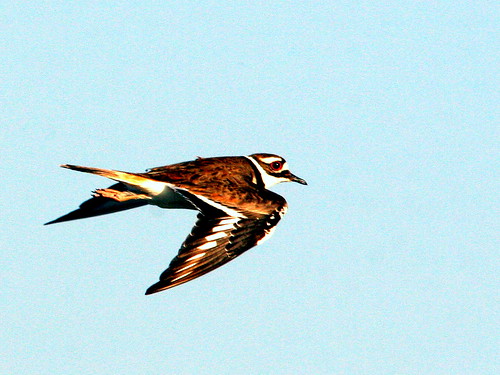
Then it performed a distraction display:
Fluttering on the ground and looking for all the world as if it were mortally wounded, it was telling me that I had approached too near its nest. I applied “reverse Killdeer logic” to quickly find the nest. If the Killdeer ran right, I went to my left. If it ran away, I turned around. As I got nearer the nest, the distraction display was more fervent, and its rufous red tail and rump became all the more visible.
Killdeers can pick the most unlikely spots for a nest. As a little kid, I once “rescued” a clutch of Killdeer eggs that were right in the middle of a parking lot. In so doing, I violated the law and, tragically, did more harm than good, as you may learn in this old Blog post.”Hatching A Plot”
It was a Killdeer chick, certainly not yet a day old:
Nearby, two nest-mates huddled together, blending perfectly with the surrounding gravel:
As I watched, the little wanderer joined the others on the nest:
Before I finished my two hour walk, it had warmed to 82 degrees, and both vulture species (Black and Turkey) wheeled in the air above, and a pair of Mottled Ducks flew overhead. Twenty-four species, exceeding my bird RDA.
I came upon another doe in the southern portion of the ESL. I thought she was sticking out her tongue, but it appears there is a sore of some kind on the front of its neck:
A buck, its antlers in early velvet, suddenly apeared near the doe, and both suddenly decided I had gotten too near: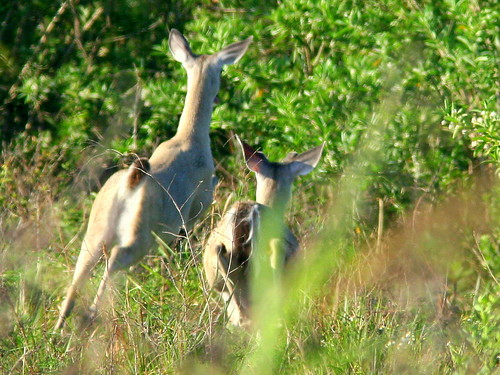
A Northern Mockingbird plucked a Ligustrum berry: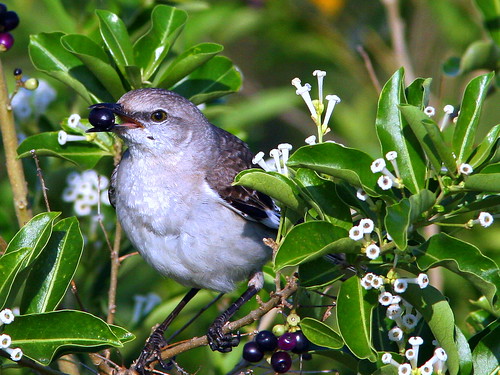
Another type of bird display meant that this Red-winged Blackbird was on its territory and told me it did not like my presence by elevating its red and yellow chevrons and singing “Konk-ra-leeee!”:
This somber female, one of his harem, was carrying nesting materials: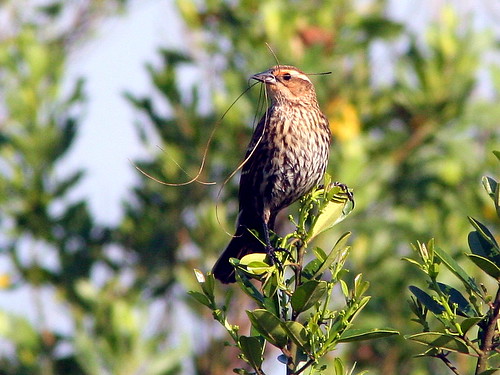
This Loggerhead Shrike was bird #24 :
A Catbird lurked nearby:
Over at the eagle nest, this adult dropped food into the empty nest, bringing my bird total for the morning up to 26 species. We missed seeing the two chicks, now free-flying for a week and a half: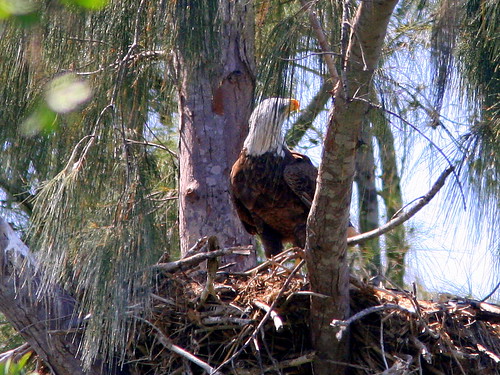
| PEMBROKE PINES BALD EAGLES |
| Nest Watch Page |
| History of the Eagle Nest |
| Protecting the Eagle Nest Site |
| EagleWatch FORUM |
| FAQs |
| Subscribe to this BLOG (RSS) |
With his permission, here is Tom Mitchell’s photo (copyright 2009) of one of the adults bringing in a fish:
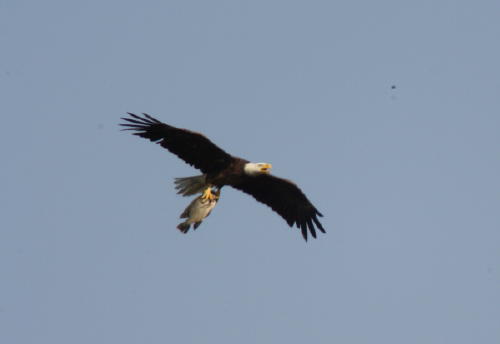
Both of our local eaglets are now flying free, but visiting the nest quite frequently to see if it contains food. Yesterday, one observer saw a very thick cloud of flies around the nest, probably emerging from pupae in the rotting leftover prey. With their keen sense of smell, the vultures also circle around the nest tree, attracted by the carrion, but unable to gat to it. Occasionally, we have seen the adult eagles drive off the vultures by swooping near them but not making contact.
This morning we arrived about 9:00 AM. Neither chick was on the nest, and no adults or chicks were visible nearby or in the Melaleucas. At 9:15 an adult flew into the nest, followed very closely by one of the chicks. Just as the adult was dropping the food, the other chick came in and almost knocked her out of the nest.
The adult quickly roosted on the tree to the east of the nest. Hope, the older and larger eaglet, began eating, and Justice was watching. This was typical behavior for the younger brother. As a small chick, he would wait patiently while the parent first fed Hope, even turning his back during the feeding. At times, the adult would deliberately feed the smaller chick despite the incessant begging of his older sister. We said that Hope, if a human, would have been classified as a “Type A” personality, and Justice as a Type “B.” Indeed Justice exhibited some of the seething resentment and frustration that some human “quiet types” suffer.
As soon as Hope lifted her head up to take a break, Justice quickly grabbed a bit of food. They began to squabble, and then Justice kept to the side. Justice tried this several times but was rebuffed. At 10 AM Hope must have had enough to eat, and flew off. Justice began picking at the leavings. At 10:15 it began to pour rain. We returned to the car, leaving Justice on the nest and the adult female still roosting on the tree to the east. The sky stayed dark and rain continued, so we left at 10:30 AM.
Here, Justice kept calling as if wanting to be fed, while Hope ignored him and continued eating: 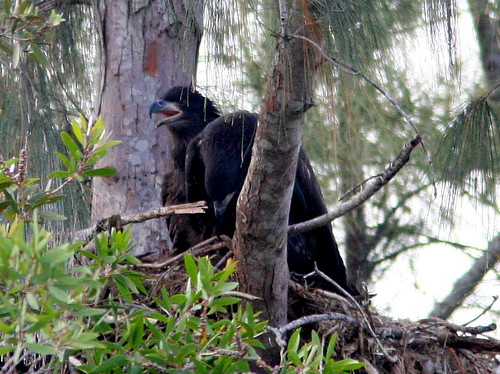
Hope (L) stood on top of the food, even though she appeared to have eaten her fill:
Both chicks appeared quite friendly as they lined up side by side, but Justice had to wait until Hope (in the foreground) took off before enjoying the leftovers:
Meanwhile, the adult roosted nearby, and scratched nonchalantly:
Butterflies are becoming more numerous in the grass around the eagle nest observation area. This is a Dainty Sulphur:
This Killdeer ran along the shore of our backyard lake:
| PEMBROKE PINES BALD EAGLES |
| Nest Watch Page |
| History of the Eagle Nest |
| EagleWatch FORUM |
| FAQs |
| Subscribe to this BLOG (RSS) |
Lou Greenwell provided this description of events he captured on this video, early this Easter morning. It illustrates the difficulty we have in interpreting eagle behavior, yet the value of observing it, and in this case, capturing it on video. The chick’s behavior towards the adult reminds me of the way the nearly-fledged nestlings “greeted” a parent bringing food. They would rush the adult and barely allow time for it to drop the prey before making a hasty retreat. Lou said:
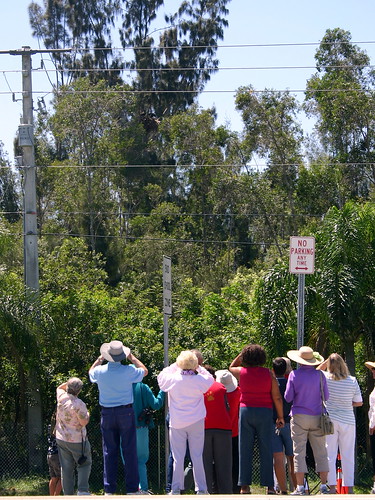
There is great value in observing nature rather than just reading about it. In the case of Bald Eagles, one can find conflicting information, often anecdotal, but probably valid in single instances.
For example, it has been said that when the chicks are almost ready to fly, the parents begin to deprive the eaglets of food. The presumed survival advantage is that the fattened chick will lose weight, and thus become more proficient in free flight. It is also stated that the parent may “lure” the eaglet out onto branches in an effort to get it to fly.
We have seen neither of these behaviors at our local Pembroke Pines, Florida nest. They climbed out on branches of their own accord. Both of the youngsters fledged at approximately 11 weeks of age, just as expected. In the days preceding their departure from the nest, we saw no decrease in the number of feedings or the size or amount of prey items. In fact, on April 5, 2009, the day after the older chick (Hope) fledged, the younger one (Justice) continued to be fed by both parents. He got so full that he did not even beg or cry out when, for the third time that morning, an adult brought in food .
Justice, alone in the nest:
Yet, later that afternoon, Jill, one of nest watchers, reported:
“Less than 10 minutes later, an adult flew to the nest with a big meal. I don’t know if it was the same adult or not. Justice squealed and carried on as if he had not been fed in days. It seemed very strange since watchers reported that he had been fed a LOT that day, and eventually had lost interest in eating more. Maybe that meal was one of his favorite foods and the other stuff offered that day tasted like spinach does to some of our kids.”
Adult returns to perch after feeding Justice:
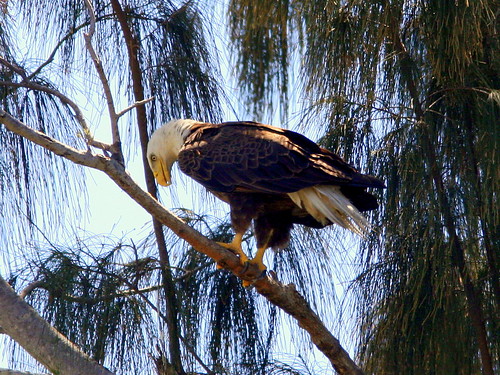
The younger chick’s personality also seemed to be undergoing a striking change. Justice was usually very passive in the nest, deferring to his younger sister at mealtime and just getting out of her way when she practiced “helicoptering” in the nest, even ignoring the indignity of being stomped upon and struck by Hope’s flailing wings. Now Justice appeared much more aggressive, yet strangely disturbed and anxious.
The next morning we knew why. You may have seen Justice’s changed demeanor in Lou Greenwell’s earlier YouTube video that may be viewed at this link <http://www.youtube.com/watch?v=SBGRZmqrocY>. Driven by an instinct that he, and certainly we, cannot fathom, his body language communicated a wildness that seemed almost foreign to the “little kid.” Lou’s video captured the next few minutes, when we discovered the reason for the chick’s distress. At once longing for the freedom of the skies, and yet so inhibited by his fear of the unknown, we saw him finally take that treacherous leap, and we shared his disappointment and pain as he seemed to plummet to the ground in failure.
Both fledglings, after returning to the nest, share a meal of White Ibis:
Our first-hand observations also document a behavior that, while not unusual, is not prominently described in many accounts of the Bald Eagle’s life history. Commonly, we read that the chicks, after fledging, tend to remain in the vicinity of the nest and beg for food for several (or about 6) weeks. Rarely do we find mention that the young actually return to the nest itself. For the past week, our local fledglings have both been found feeding and resting on the nest many times, often together. The adults continue to drop food in the nest, even if the young birds are not in sight. It will be interesting to see how long they follow this practice.
To read many up-to-the-minute reports on the status of the eagles, be sure to visit the FORUM.
[For those who don’t watch “B” Western movies, see WIKIPEDIA : A chuckwagon was originally a wagon that carried food and cooking equipment on the prairies of the United States and Canada… They would form a part of a wagon train of settlers or feed nomadic workers like cowboys or loggers… the invention of the chuckwagon is attributed to Charles Goodnight, a Texas rancher who introduced the concept in 1866… “Chuck” was then a slang term for food.]















